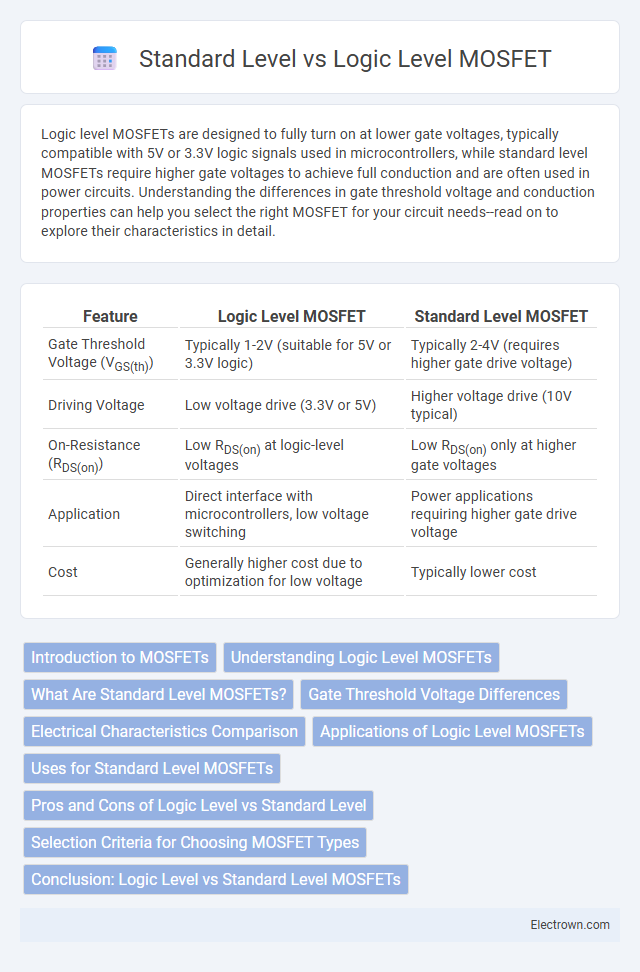Logic level MOSFETs are designed to fully turn on at lower gate voltages, typically compatible with 5V or 3.3V logic signals used in microcontrollers, while standard level MOSFETs require higher gate voltages to achieve full conduction and are often used in power circuits. Understanding the differences in gate threshold voltage and conduction properties can help you select the right MOSFET for your circuit needs--read on to explore their characteristics in detail.
Table of Comparison
| Feature | Logic Level MOSFET | Standard Level MOSFET |
|---|---|---|
| Gate Threshold Voltage (VGS(th)) | Typically 1-2V (suitable for 5V or 3.3V logic) | Typically 2-4V (requires higher gate drive voltage) |
| Driving Voltage | Low voltage drive (3.3V or 5V) | Higher voltage drive (10V typical) |
| On-Resistance (RDS(on)) | Low RDS(on) at logic-level voltages | Low RDS(on) only at higher gate voltages |
| Application | Direct interface with microcontrollers, low voltage switching | Power applications requiring higher gate drive voltage |
| Cost | Generally higher cost due to optimization for low voltage | Typically lower cost |
Introduction to MOSFETs
MOSFETs (Metal-Oxide-Semiconductor Field-Effect Transistors) are essential semiconductor devices used for switching and amplifying electronic signals. Logic level MOSFETs are designed to operate efficiently at lower gate voltages, typically compatible with microcontroller outputs (around 5V or less), while standard level MOSFETs require higher gate voltages (often 10V or more) for optimal conduction. Understanding the distinction between these types helps you select the appropriate MOSFET for low-voltage digital circuits or high-power applications, ensuring reliable performance and efficient power management.
Understanding Logic Level MOSFETs
Logic level MOSFETs are designed with a lower gate threshold voltage, enabling them to fully switch on at the typical voltages used in microcontroller and digital logic circuits, often around 5V or less. These devices provide efficient switching performance in low-voltage applications, reducing power loss and heat generation compared to standard level MOSFETs that require higher gate voltages, typically 10V or more, to achieve full conduction. Selecting a logic level MOSFET ensures your circuit operates reliably within the voltage constraints of modern digital electronics.
What Are Standard Level MOSFETs?
Standard level MOSFETs are designed to operate efficiently at higher gate voltages, typically around 10 to 15 volts, making them suitable for applications with ample gate drive voltage. These devices have higher threshold voltages compared to logic level MOSFETs, which require a lower gate voltage, usually 4.5 volts or less, to switch fully on. Understanding the difference helps you select the appropriate MOSFET for your circuit's voltage requirements and ensures optimal performance and efficiency.
Gate Threshold Voltage Differences
Logic level MOSFETs have a lower gate threshold voltage, typically around 1 to 2 volts, enabling them to fully turn on with standard logic signals from microcontrollers. Standard level MOSFETs require a higher gate voltage, often 4 to 10 volts, to switch fully, which can limit their use in low-voltage applications. Choosing a logic level MOSFET ensures Your device operates efficiently with typical 3.3V or 5V logic levels without additional gate drivers.
Electrical Characteristics Comparison
Logic level MOSFETs feature a lower gate threshold voltage (typically 1-2V) enabling them to fully turn on with standard microcontroller logic signals, whereas standard level MOSFETs require higher gate voltages (around 4-10V) for conduction. Logic level devices exhibit lower on-resistance (R_DS(on)) at logic voltages, improving efficiency and reducing heat dissipation in low-voltage drive circuits. Your choice directly impacts switching performance, power loss, and compatibility with control voltage levels in electronic designs.
Applications of Logic Level MOSFETs
Logic level MOSFETs are ideal for low-voltage and battery-powered applications such as portable electronics, microcontroller-driven circuits, and power management systems because they fully turn on at lower gate voltages (typically around 4.5V or less). Their ability to operate efficiently with logic-level signals from digital ICs makes them perfect for switching loads like motors, LEDs, and small power supplies directly driven by microcontrollers or logic gates. Using logic level MOSFETs ensures better performance and reliability in your projects where gate drive voltage is limited.
Uses for Standard Level MOSFETs
Standard level MOSFETs are commonly used in applications requiring higher voltage handling and power dissipation capabilities, such as motor drives, power supplies, and industrial equipment. Their higher threshold voltage makes them suitable for switching in circuits powered by voltages above typical logic levels, ensuring reliable operation in demanding environments. Your projects involving high current loads or less sensitive control signals benefit from the robustness of standard level MOSFETs.
Pros and Cons of Logic Level vs Standard Level
Logic level MOSFETs offer lower gate threshold voltages, enabling direct drive from microcontrollers without additional gate drivers, which simplifies design and reduces power consumption. Standard level MOSFETs provide higher voltage and current ratings, making them suitable for high-power applications but often require higher gate voltages for full conduction, increasing complexity and losses. Your choice depends on application voltage levels and power requirements, balancing ease of control against performance and efficiency.
Selection Criteria for Choosing MOSFET Types
Selection criteria for choosing between Logic level and Standard level MOSFETs primarily depend on the gate drive voltage and application requirements. Logic level MOSFETs are optimized for lower gate voltages (typically 4.5V to 5V), making them ideal for interfacing directly with microcontrollers and low-voltage logic circuits. Your choice should consider the required RDS(on), switching speed, and thermal performance to ensure efficient operation within your system's voltage constraints.
Conclusion: Logic Level vs Standard Level MOSFETs
Logic level MOSFETs feature lower gate threshold voltages, allowing them to fully switch on at standard logic voltages (e.g., 5V or 3.3V), making them ideal for microcontroller and low-voltage applications. Standard level MOSFETs require higher gate voltages (typically 10V) to achieve low Rds(on) and are better suited for high-power or industrial circuits with dedicated gate drivers. Selecting between logic level and standard MOSFETs hinges on application voltage compatibility and switching efficiency requirements.
Logic level vs Standard level MOSFET Infographic

 electrown.com
electrown.com